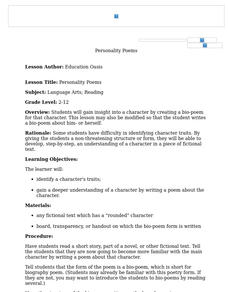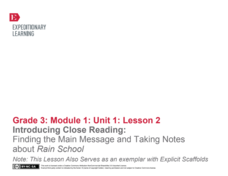Curated OER
Personality Poems
Students create a bio-poem for themselves or characters in stories they have read. They explore common character traits.
Curated OER
In Character
Students fill out a character trait graphic organizer about characters in a book that they are reading. In this characters lesson plan, students see how traits relate to character actions.
EngageNY
Close Reading of Thank You, Mr. Falker: Identifying the Superpowers of Reading
Third graders read excepts from the story, Thank You, Mr. Falker in order to gain practice in understanding an unfamiliar story by focusing on the details. They use a worksheet, embedded in the plan, which directs them to certain...
EngageNY
Introducing Close Reading: Finding the Main Message and Taking Notes About Rain School
This second lesson in a larger unit is perfect for the beginning of the year because it explicitly teaches 3rd graders how to use close reading skills by identifying unfamiliar words, figuring out the gist, and defining important...
Roald Dahl
Roald Dahl Matilda Lesson Plans
Fifty eye-catching pages contain six lessons about Roald Dahl's novel, Matilda. Each lesson has a theme and covers a different subject—literacy, social-emotional learning, science, and geography. Scholars analyze characters, examine...
Curated OER
James and the Giant Peach Character Study
Every book has a few great characters, but James and the Giant Peach is the only one whose characters travel in a piece of fruit. The class creates T-charts for the main characters of the novel, while reading the book. They write actions...
Curated OER
Story Pyramids
Young writers generate descriptive words. They use pictures of various landscapes (from books, magazines, or the Internet) and complete a story pyramid. The pyramid (included here) asks to describe the main character, the setting, and...
Curated OER
Out of the Dust: Biopoem
As part of their study of Out of the Dust, readers create a biopoem for one of the characters in Karen Hesse's 1998 Newbery Medal winning verse novel.
Curated OER
Character Diary Entry (3+)
Students better explain a character after examining their traits as well as trying to write a diary entry from their perspective.
Curated OER
Character Cluster
Third graders practice identifying characters and story elements by creating a character cluster in class. For this story analysis lesson, 3rd graders discuss the story Snow White and identify the characteristics of the evil witch....
Curated OER
Trumpet of the Swan Character Study
In this literature worksheet, students complete a study of their favorite character from the Trumpet of the Swan. They fill in the name of their favorite character, complete a table with words that describe that character, and use those...
Curated OER
December
Students create snowflake similes, Kwanzaa plaques, menorah banners, and more for the month of December. In this December activities lesson plan, students also analyze characters in How the Grinch Stole Christmas.
Curated OER
Character Scrapbook Teacher's Guide
Students analyze a book's characters and create a scrapbook to print and save. In this on line interactive characterization lesson plan, students identify character traits and gain a deeper understanding of a book's characters.
Curated OER
Analyze The Learner; Chocolate Fractions
Third graders describe, represent and compare fractions using pieces of a chocolate bar. In this fractions lesson, 3rd graders demonstrate how to read and write fractions correctly. Students then integrate technology by using...
Curated OER
We Like to Imagine - Animals
Young scholars describe a pretend animal. They read "The After School Monster." Students read other books and discuss whether or not the characters are real. Young scholars make a drawing of a pretend animal and of a real animal. They...
Curated OER
Literature Study
Students create a PowerPoint presentation about a chapter book that they have read. They include what the book is about, they include characters, and a brief summary about the book.
Orange County Department of Education
The Lost and Found
Third graders explain the definition of integrity and respect and provide examples from the story The Lost and Found's characters and their own lives that illustrate both. They describe in their journals why and how they think Wendell...
Curated OER
Writing Own Tale
Third graders read The First Strawberries and complete a character chart. In this writing a tale instructional activity, 3rd graders discuss viewpoints and identify character traits. Students complete character charts and write...
Curated OER
Sharing the Joy of a Garden
Students see that a garden is a place where an individual can go for inner peace and solitude. They discover that a garden is to be shared. Students describe the importance that a garden has to the environment and lives of individuals...
Curated OER
Graphic Organizer Collection: Character
In this collection of graphic organizers for a literature unit, students will complete 22 different graphic organizers on the topic of character development. For example, this collection includes character analysis and various attribute...
Curated OER
Characterization
Students draw pictures to generate ideas about a character. They use prewriting skills to plan written work. They then dictate or write detailed descriptions of familiar person, places, objects, or experiences.
Curated OER
The Common Core Literacy Standards - Grade 3 Posters
Brighten your third grade classroom with this series of colorful Common Core displays. Including all of the English Language Arts standards and substandards, each with supporting illustrations and examples, this resource provides clear...
For the Teachers
Sequence Plot Chart
Your kids can identify the plot sequence of a short story, but what about an informational article? Have them examine the chronological order of events in informational texts with a activity on the sequence of events.
For the Teachers
Story Strips Sequencing
What happens next? Work on story sequence with a lesson that prompts kids to put a story back in order. Additionally, they discuss what would happen if one event was missing from the sequence.























